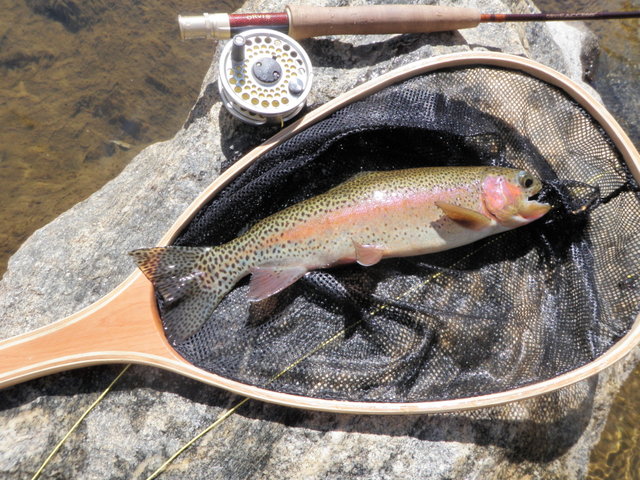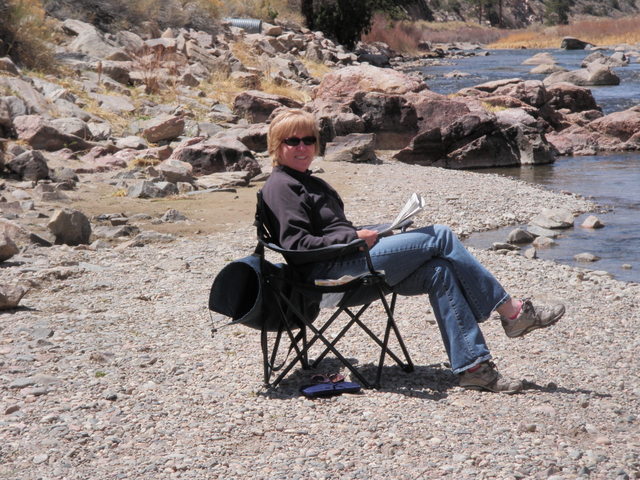Time: 9:30AM – 4:00PM
Location: Salt Lick Access
Fish Landed: 20
Arkansas River 04/26/2013 Photo Album
I sent an email to Steve Supple asking if he was sufficiently recovered from a recent cold to join me on another fishing expedition to the Arkansas River. He replied on Thursday morning that he was taking antibiotics and felt good enough to make the trip on Friday. Judging from the fishing reports on the Royal Gorge Angler web site, I felt there was a slight chance of hitting the caddis emergence, but expected to at least have some decent action on BWO’s and caddis pupa with movement. The weather forecast called for high temperatures reaching 70 degrees with a period of cloudiness between 11 and 2 with a 30% chance of showers.
We got off to a nice early start and arrived at the Salt Lick Access area just above Five Points by 9:30AM, and we were ready to fish shortly thereafter. We noticed quite a few more fishermen in the pullouts than seen on our last trip in early April. I began my day of fishing in the nice run directly across from the steps down from the parking lot and rigged with a strike indicator, split shot, beadhead hares ear nymph and beadhead bright green caddis pupa. This combination didn’t produce any action in the long run so I crossed at the top and quickly prospected the small north braid and then moved opposite Steve in the long deep pool. This area also did not reward me for my casting, and meanwhile, Steve was landing several fish on his caddis larva imitation.
Hearing of Steve’s success with the caddis larva, I swapped the green caddis pupa for a go2 caddis as it showcases a shiny bright green body. At the top of the long deep pool another small channel enters from the north side of the river and features a deep hole at the bend just before joining the main river. The hole is 50% covered by foam, and on one of my drifts on the edge of the foam, I hooked and landed my first fish of the day, a small brown that fell for the hares ear. Next I moved up along the right, north bank to an area with large pockets between widely spaced exposed boulders, and here I landed a second medium size brown.
At slightly before 11AM I approached a nice run of moderate depth around some large rocks and I spotted five or more BWO’s fluttering up from the stream. As forecast by the Weather Channel, some clouds moved in and blocked the sun, and I was pleased to see some rising fish as the BWO hatch intensified. This prompted me to clip off the nymphs and I tied on a CDC BWO and this produced quite well as I landed six browns over the next hour or so from three separate deep smooth pool areas. It was too difficult to see rises in the faster moving water, but the smooth slower moving pools revealed fish actively feeding on the surface. At 11:45 it actually began to sprinkle briefly and I wasn’t seeing any likely pools or rising fish so I reeled up my fly and waded back to the highway side of the river and returned downstream and discovered Steve in the nice long deep pool just upstream from the steps and parking lot. Steve suggested I wade in above him as several fish were rising so I took his advice and waded in a few feet and began making downstream drifts in a nice current seam approximately 15 feet out from my position. Sure enough I saw a quick slurp and set the hook and landed number nine on the morning, a small nine inch rainbow.
Steve and I ate our lunches on one set of steps below the parking lot and after lunch I decided to walk down along the shoulder of highway 50 to the observation shelter at Five Points and then work my way back up to the parking lot. Steve on the other hand elected to fish in the nice pool and move upstream from there. As I arrived at Five Points I mentally evaluated my options. The BWO hatch appeared to have ended even though it remained relatively cloudy. We appeared to be too early for the caddis hatch as we saw minimal signs of caddis activity and my attempts to fish pupa with movement yielded nothing. I decided my best option was to prospect the ten feet of water along the bank with a Chernobyl ant as an indicator and a beadhead hares ear as my workhorse dropper. This strategy worked like a charm, and I landed eight additional fish in the two hours after lunch on the Chernobyl ant and hares ear combination. All the fish grabbed the hares ear except for one aggressive brown that slammed the Chernobyl.
The last two went for the hares ear as I swung it or lifted to recast so I decided to return to the nymph rig in case the fish were tuning into active caddis pupa. I removed the Chernobyl ant and replaced it with a strike indicator and split shot and then kept the BHHE as the top fly and added a beadhead bright green caddis pupa as the point fly. I fished these two flies with quite a bit of movement and landed three additional browns including one decent 12 inch fish. Just after I landed number twenty Steve appeared on the bank above me and asked how I was doing and whether I wanted to stay or move on. I asked if I could fish the remaining twenty yards before I reached the parking area, and he agreed. I failed to land any additional fish in two attractive areas, and then just before approaching the beach by the stairs, I snagged the flies on a large submerged rock and broke them both off. This made my decision to quit easy.
Steve and I kept our waders on as we decided to check out some water downstream in Canon City for fish feeding on caddis on the surface; however, when we parked in a parking lot east of Canon City and checked the water, it appeared to be dead. We decided to remove our gear and begin our return trip at around 3:45.
It was a decent day but we never encountered any significant caddis activity and the fish were smaller on average than normal. Steve and I agreed that the best action was the BWO hatch that occurred from 11AM to 12PM. We even shook the willows at the area east of Canon City and saw no caddis flitting up from the branches. The quest for Arkansas River caddis continues.

















